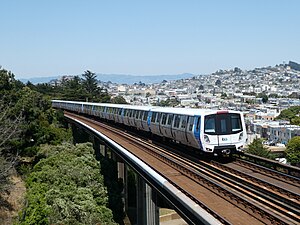
Back النقل السريع لمنطقة الخليج Arabic БАРТ Bulgarian বে এরিয়া র্যাপিড ট্রানজিট Bengali/Bangla BART CY Bay Area Rapid Transit German BART (fervojo) EO BART Spanish حمل و نقل سریع خلیج FA Bay Area Rapid Transit Finnish Bay Area Rapid Transit French
| Bay Area Rapid Transit (BART) | |
|---|---|
 | |
 BART train in southern San Francisco | |
| Overview | |
| Locale | San Francisco Bay Area (Alameda, Contra Costa, San Francisco, San Mateo, and Santa Clara counties) |
| Transit type |
|
| Number of lines |
|
| Number of stations | 50 (7 planned/proposed) |
| Daily ridership | 169,800 (weekdays, Q3 2024)[1] |
| Annual ridership | 48,119,400 (2023)[2] |
| Chief executive | Robert Powers[3] |
| Headquarters | 2150 Webster Street Oakland, California |
| Website | bart |
| Operation | |
| Began operation | September 11, 1972 |
| Operator(s) | San Francisco Bay Area Rapid Transit District |
| Character | Fully grade separated with at-grade, elevated and underground sections |
| Number of vehicles | 805 total, with 700+ available for service;[4] with 8 DMU vehicle sets (eBART);[5] and 4 AGT vehicle sets |
| Train length | |
| Headway | 20 minutes (4 of 5 service lines), 10 minutes (1 service line)[7] |
| Technical | |
| System length | 131.4 mi (211.5 km)[5] |
| Track gauge |
|
| Minimum radius of curvature | 120 m (394 ft) |
| Electrification | Third rail, 1 kV DC[5][8] |
| Average speed | 35 mph (56 km/h)[5] |
| Top speed |
|
| Part of a series of articles on |
 |
Bay Area Rapid Transit (BART) is a rapid transit system serving the San Francisco Bay Area in California. BART serves 50 stations along six routes and 131 miles (211 kilometers) of track, including eBART, a 9-mile (14 km) spur line running to Antioch, and Oakland Airport Connector, a 3-mile (4.8 km) automated guideway transit line serving Oakland International Airport. With an average of 169,800 weekday passenger trips as of the third quarter of 2024 and 48,119,400 annual passenger trips in 2023, BART is the sixth-busiest rapid transit system in the United States.
BART is operated by the San Francisco Bay Area Rapid Transit District which formed in 1957. The initial system opened in stages from 1972 to 1974. The system has been extended several times, most recently in 2020, when Milpitas and Berryessa/North San José stations opened as part of the under construction Silicon Valley BART extension in partnership with the Santa Clara Valley Transportation Authority (VTA).[10]
- ^ "Transit Ridership Report Third Quarter 2024" (PDF). American Public Transportation Association. November 20, 2024. Retrieved November 23, 2024.
- ^ "Transit Ridership Report Fourth Quarter 2023" (PDF). American Public Transportation Association. March 4, 2024. Retrieved September 5, 2024.
- ^ Fracassa, Dominic; McBride, Ashley (July 25, 2019). "BART selects Robert Powers as new general manager". San Francisco Chronicle. Retrieved July 25, 2019.
- ^ "New Train Car Project". San Francisco Bay Area. December 29, 2020. Retrieved March 28, 2021.
- ^ a b c d e f Cite error: The named reference
SystemFactswas invoked but never defined (see the help page). - ^ Cite error: The named reference
Train Size Change 2023was invoked but never defined (see the help page). - ^ "BART unveils reimagined schedule starting in September aimed at increasing ridership" (Press release). Bay Area Rapid Transit. August 14, 2023. Retrieved August 28, 2023.
- ^ "BART – Car Types". Bay Area Rapid Transit. Retrieved April 8, 2021.
- ^ Cite error: The named reference
OpsAnalysiswas invoked but never defined (see the help page). - ^ Glover, Julian (May 19, 2020). "BART announces service start date for long-awaited Milpitas, San Jose Berryessa stations". ABC7 News. Retrieved May 19, 2020.


